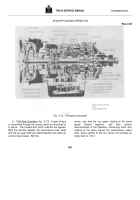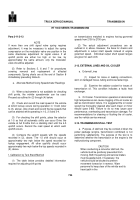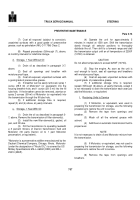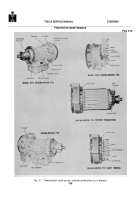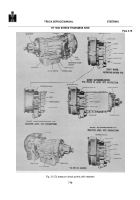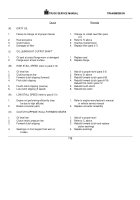TM-5-3805-254-14-P-2 - Page 711 of 894
TRUCK SERVICE MANUAL
TRANSMISSION
HT 700D SERIES TRANSMISSIONS
Para 3-11/3-13
NOTE
If more than one shift signal valve spring requires
adjustment, it may be necessary to adjust the spring
compression on the modulator valve one position in the
same directionas adjustment for signal valves. If all
upshift points are either too high or too low, by
approximately the same amount, only the modulator
valve should be adjusted.
(5
)
Refer to Sections 5, 6 and 7 for procedures
covering
removal
and
replacement
of
affected
components. Spring charts are at the end of Section 8
immediately preceding foldouts.
e
.
Alternate Method Using Speedometer Readings
(1
)
When a tachometer is not available for checking
shift points, the vehicle speedometer can be used.
Proceed as outlined in (2) through (4) below.
(2
)
Check and record the road speed of the vehicle
at which lockup occurs during operation in 1-hold (refer
to (3), above). Also check and record the top speeds that
can be attained while operating in 1-2, 2-3 and 3-4.
(3
)
For checking the shift points, place the selector
at 1-5 so that all automatic shifts can occur Drive the
vehicle at full throttle from a standing start until the 4-5
upshift occurs. Record the road speed at which each
upshift occurs.
(4
)
Compare the upshift speeds with the speeds
recorded in (2), above. The 1-2 shift should occur at
approximately two mph below the speed recorded for
lockup engagement. All other upshifts should occur
approximately two mph below the top speeds recorded in
(2), above.
f. Calibration by Test Stand Method
(1
)
The table below provides detailed information
required for adjusting shift points
on transmissions matched to engines having governed
speeds from 2100 to 2700 rpm.
(2
)
The actual adjustment procedures
are
as
outlined in d, above. However, the base for checks and
adjustments is output shaft speeds instead of engine
governed speed.
Individual output shaft speed ranges
are given for each shift.
3-12. EXTERNAL LINES AND OIL COOLER
a
.
External Lines
(1
)
Inspect for loose or leaking connections,
worn or damaged hoses, tubing and loose fastenings.
(2
)
Examine the radiator coolant for traces of
transmission oil. This condition indicates a faulty heat
exchanger.
b
.
Oil Cooler. Transmission operation at abnormally
high temperatures can cause clogging of the oil cooler as
well as transmission failure. It is suggested the oil cooler
system be thoroughly cleaned after each major or minor
rebuild (para 3-8d). Failure to do so may cause poor
performance, overheating and transmission damage. For
recommendations for cleaning or flushing the oil cooler,
see the vehicle service manual.
3-13. TRANSMISSION STALL TEST
a
.
Purpose. A stall test may be conduct-d when the
power package (engine, transmission combined) is not
performing satisfactorily. The purpose of the test is to
determine whether the transmission or the engine is the
malfunctioning component.
CAUTION
When conducting a converter stall test, the
vehicle must be positively prevented from
moving. Both the parking and service brakes
must be applied and, if necessary, the
vehicle should be blocked to prevent
movement forward or in reverse.
Warn
personnel to keep clear of the vehicle and its
travel path in the
704
Back to Top




